Rules for growing Dendrobium orchids
Orchid Dendrobium (Dendrobium) belongs to the genus of the orchid family, plants differ in shape and variety of flowers, features of growth and development. Having studied the rules of care, transplantation and reproduction for the Dendrobium orchid, it will turn out to grow a beautiful flower at home.
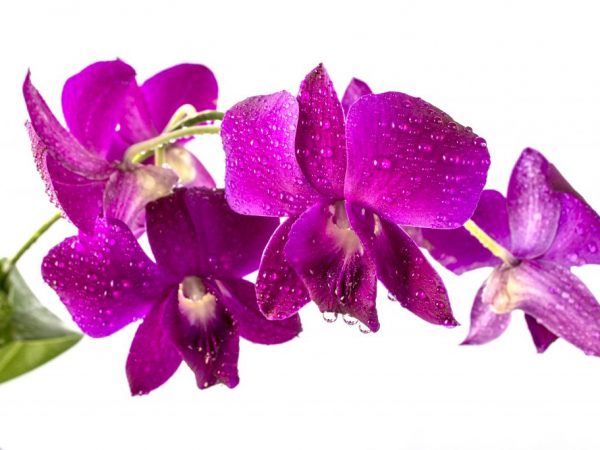
Rules for growing Dendrobium orchids
Description of the variety
Dendrobium (Dendrobium) is an unpretentious variety, suitable for growing at home. The name Dendrobium means that it grows on a tree. Dendrobium has about 1200 varieties, which have their own characteristics. The root system of the plant is represented by the rhizome, which is a shoot that unites pseudobulbs.
Dendrobium orchids at home grow from 40 to 90 cm in height, cylindrical pseudobulbs are located on the stem, lanceolate leaves are 5-10 cm. Peduncles grow with 1-4 flowers. In nature, the colors of Dendrobium orchids are different: white, yellow, orange, lilac and others. The homeland of the flower is Australia, the countries of the south of Asia, New Zealand.
Orchid species
Indoor varieties of Dendrobium Phalaenopsis and Dendrobium Noble (Royal blue, Black beautiful, Noble white) are suitable for growing at home.
Dendrobium flowers of the Noble and Bukeshotsveshny varieties grow and usually do not shed their foliage, but this happens only in some cases.
Other types of Dendrobium orchids are common in the temperate warm zone: Nestor, Polar Fire, Mini, Starclass, Compactum, Sena Red, Parisha, Moniliform.
Dendrobium Pierre
The Pierrera variety represents the orchid family, throwing off the leaves before flowering. This species belongs to the moderately cold temperature zone. During the leafless phase, orchids are abandoned plants; upon completion of the dormant phase, leaves appear on them.
Dendrobium King
Dendrobium Kinga (Kingianum), rocky orchid - has cylindrical stems, covered with white scales, grow up to 25-30 cm.The length of Kinga leaves is 10 cm, width - 2-3 cm, they are large and thin. On the upper peduncle, 5-7 flowers grow, their colors are white, with a pink tint, purple. The inflorescences consist of 2-9 flowers, with a diameter of up to 1 cm. In the spring, when sprouts appear, watering and fertilization, during the dormant period, watering is stopped.
Dendrobium Berry
Berry ode is a bush form of a hybrid that blooms from late spring to winter. Flowers are obtained in different shades: from white to dark crimson. It grows up to 30 cm, up to 9 flowers appear on the inflorescences.
Dendrobium Phalaenopsis
The second name of the plant is Dendrobium Bactrian (Biggibum). The leaves of the plant are dense, tough, the pseudobulb grows up to 60 cm.The duration of flowering in Dendrobium Phalaenopsis is 3-4 months.Phalaenopsis is a plant that loves warmth, good lighting and 50% humidity. When the buds of the pseudobulb have awakened, a new shoot is formed.
Dendrobium Stardust
Stardust has a thin and long pseudobulb: up to 50 cm long, 1.5-2 cm wide.The leaves are lanceolate, the flowers are pale yellow or red-orange with dark veins, up to 6 cm in diameter.
Dendrobium Aggregatum
Crowded dendrobium (Agregatum, Lindley) - it turns out to grow pseudobulbs up to 7 cm in length, have yellowish, grooved colors. Single leaf up to 6 cm long, dark green in color. The inflorescence has 5-15 golden or yellow flowers with orange lines. Fragrant flowers up to 4 cm in diameter, smell of honey. Pale green codist leaves grow up to 10 cm in length.
Dendrobium Farmery
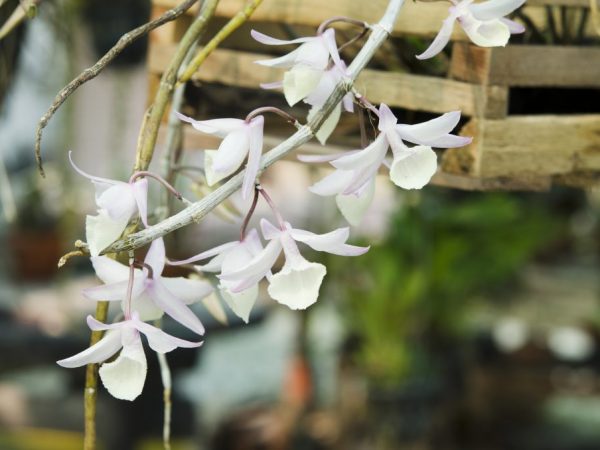
Farmeri variety blooms in spring
Farmeri grows up to 30-45 cm, pseudobulbs are erect. The length of the leaves reaches 8-15 cm, 2-4 units grow at the top of the bulb. Peduncle hanging down to 20-30 cm in length, several peduncles can be produced at the same time. The inflorescences consist of 14-35 flowers with a diameter of up to 5 cm. The flowering period is spring.
Apollo
Apollo is a hybrid with dense pseudobulbs and green leaves. Several flowers with a pleasant smell ripen on the peduncles.
Hibiki
Hibiki has beautiful pink flowers of small size with an orange throat. Flowers are located along the pseudobulb, along its entire length. The height of the bulb is 12 cm.
Harveyanum
Harveyanum needs to be grown in light, breathable and permeable soil for orchids, height from 15 to 23 cm, flowering time from mid-January to December.
Emma, Sonya
Emma, Sonya - at a height of 30-60 cm, there are white, pink and gold colors.
Nobile, Akatsuki
Varieties Nobile (Mobile, nobile), Nobi and Akatsuki have a lilac color and a light lip, the flower grows up to 4 cm. The aroma of Dendrobium Nobi, Nobile, Akatsuki is weak floral, saturated in the morning in a sunny place. Plants contain 3-4 pseudobulbs covered with flowers.
Papilio
According to the description, the Papilios dendrobium flower grows from 30 to 45 cm, the soil is light, water and breathable for orchids, blooms from January to December. Pseudobulbs are 30-45 cm long, leaves are 4-5 cm long, a flower is 4-7 cm in diameter.
Nobile Irene Smile
Nobile Irene Smile (Dendrobium Nobi, Nobile, Nobilis, Nobile, Star Klass Lilak) are white indoor hybrids, flowering time about 12 weeks, height 50 cm, have fleshy pseudobulb stems and green leaves. The plant teens are used in Chinese medicine to strengthen the immune system and relieve physical fatigue, the drugs are available in capsules.
Loddigesa
Loddigesa has a color from pink to purple, height 10-20 cm, pseudobulbs 8-15 cm long. 1 flower grows on a peduncle. The plant will bloom from February to June with a peak in April. In nature, there are cases when Loddigesa does not bloom, it should be forced to form buds and buds.
Growing
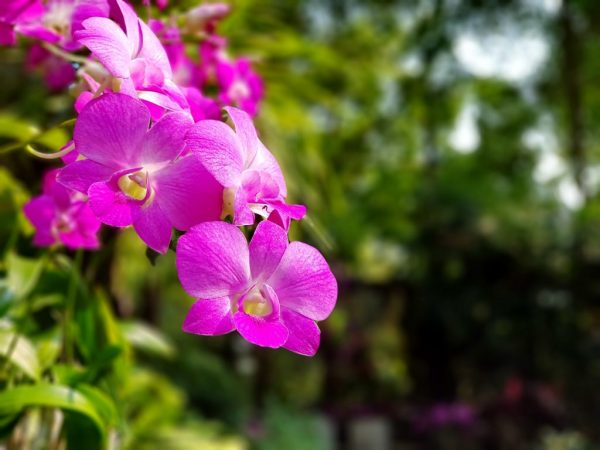
It's easy to grow a plant at home
Feng Shui supports the cultivation of orchids at home, based on it, plants are female flowers. It is easy to grow dendrobium at home, subject to special conditions and requirements.
Temperature
Dendrobium is thermophilic, in winter the temperature during the day is 15-20 ° С, at night - 6-12 ° С.
In summer for the Dendrobium orchid, the temperature during the daytime is 18-25 ° C, at night - 14-20 ° C.
The temperature during the rest period in winter is 15-18 ° C at night, 20-25 ° C during the day.
Lighting
The east and west sides of the house will do; darkening will be required on the south window.
Watering
In spring and summer, watered well during growth, the soil should be moist. In winter, watering the orchid is required less often, the dry content is observed.
Care
Studying the rules for transplanting, choosing a pot, substrate, watering will help you figure out how to properly care for the Dendrobium orchid.
Transfer
Dendrobium orchid transplant is carried out every 3 years, provided:
- compaction or decomposition of the substrate;
- the container is filled with roots;
- acidification or salinization of the substrate from irrigation;
- decay of roots;
- after purchase, the orchid is transplanted.
It is worth replanting plants carefully, as the roots of orchids are fragile.
Transplant pot
Opaque pots are selected for transplanting. It will be possible to transplant an orchid subject to the rules:
- the orchid is kept in a solution of succinic acid for 10-15 minutes (the tablet is dissolved in 1 liter of warm water);
- the roots are filled with moisture and change color to greenish-milky;
- after they are dried for 30 minutes and placed on a substrate in a pot;
- pseudobulbs are placed closer to the edge;
- the root neck remains on top;
- if the roots are evenly spaced, the gaps are filled with bark.
Watering
Watering Dendrobium after 3-14 days, it depends on the size of the roots and the healing of wounds from damage received during the transplant.
Dendrobium substrate

The bark must be disinfected before use.
Caring for Dendrobium includes the choice of substrate when planting. The main components are:
- pine bark of medium size;
- charcoal;
- crushed foam;
- pebbles;
- broken brick.
Before use, the substrate is disinfected - spilled with boiling water and dried.
The consequences of improper care
The cause of problems is improper care, they will need resuscitation.
Root rot
Damage to the root system occurs due to improper maintenance:
- excess moisture in the substrate;
- overfeeding with fertilizers;
- caked substrate;
- lack of watering;
- overheating of the plant.
If the orchid is tightly in the pot, the roots are in order, if they are brown, hollow, slimy, it is worth addressing the problem. The flower is pulled out of the pot, roots with damage or rot should be cut off. Then they are sprayed with a solution of phytosporin, and the ground part is also subject to processing. The orchid should be planted in new soil after the moisture has dried.
The trunk is rotting
The trunk starts to rot from the bottom up. This is due to the development of root rot. When signs of a disease are detected, treatment with phytosporin and transplantation into new soil are used.
Dendrobium withers
Due to improper care of the Dendrobium orchid, the leaves fade and turn yellow, they become lethargic and fall off. Main reasons:
- attack of spider mites;
- leaves begin to rot due to waterlogging;
- tissues atrophy with a lack of moisture;
- root damage often occurs.
If the leaves of the orchid become soft and look like a rag, they are cut off and the cut sites are treated with a fungicide, watering is stopped until the soil dries up to 2/3 of the height of the container.
Cracking
Cracks begin to appear in the following cases:
- if the plant has fallen, the leaf is bent, mechanical damage begins to appear;
- excess nitrogen - to save the roots, they are removed from the substrate, new land will be needed for transplanting, they are fed with potash and phosphorus fertilizers for 3 months, restoration will last a year;
- temperature difference, hypothermia after watering;
- irrigation failures lead to leaf damage.
Leaves turn yellow
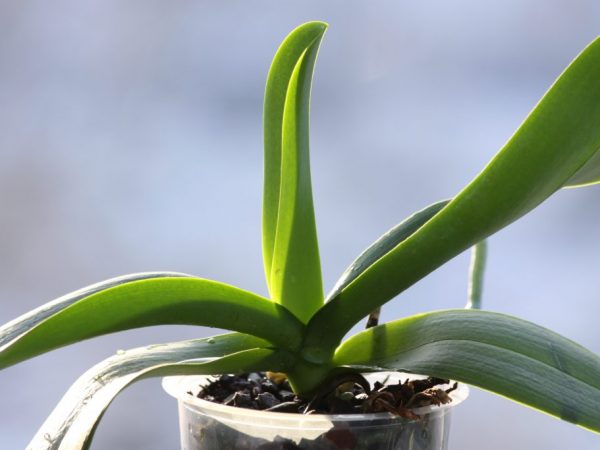
Watering errors can lead to yellowing of the leaves.
Causes of yellowing:
- the flower is aging;
- exposed to diseases and pests;
- a chemical burn appeared on the stem or other parts of the plant with fertilizers or growth stimulants;
- transferred stresses: relocation, lack of lighting, humidity, unfavorable air temperature, irrigation errors.
If the leaves of the plant turn yellow, steps are taken to treat and rehabilitate it.
Loss of buds and flowers
Reasons for dropping buds:
- change of habitat;
- lack of lighting;
- overheat;
- erroneous watering;
- hypothermia.
Planting orchids should not be near fruits, they release ethylene, which affects the aging of flowers and buds.
Sticky drops
Sticky droplets can appear on leaves, bulbs, and young shoots. The reasons for their occurrence: attraction of insects, protection from external factors, excess fertilizers, irrigation errors and the presence of pests.
Orchid propagation
Dendrobium is propagated by children, by cuttings and by dividing the bush.
Reproduction by children
The baby is a small process with root buds.
To separate and plant the baby will turn out:
- if the baby has grown to 5 cm, it is cut off;
- the roots are fed with moisture;
- a baby is placed in a half-filled pot;
- the substrate is added and compacted;
- the growth point remains on top.
The seedling is fixed with a support; greenhouse conditions are not needed. It is required to spray the top layer of the substrate between waterings. Closer to autumn, children with roots grow on the stems, they should be separated and planted in new pots.
Seed propagation
Reproduction using seeds has its own characteristics. Seeds are sown on a nutrient medium in special flasks, grown in a laboratory.
Dividing the bush
How to split a bush:
- pseudobulbs are separated from the mother plant;
- cuts are made into cuttings with 2-3 nodes, 10 cm long;
- planting is carried out on raw sphagnum, in an area or greenhouse closed with a zip package.
The temperature is maintained at a level of 20-25 ° C, ventilation and watering of the planted are required. After 2-3 weeks, the plant takes root on cuttings, then they should be planted in pots with a substrate.
Cutting at home
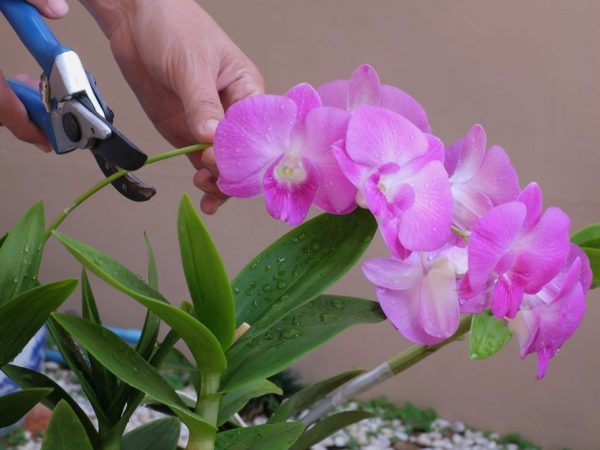
Propagating by cuttings is not difficult
Cutting is a method of reproduction of Dendrobium, while the apical part of the shoot is trimmed or the shoot is divided into parts 10-12 cm long. The cuttings are kept in a root solution for 24 hours, then rooted in a sterile container, water is added to the bottom of the container. In a few months, the plants will have a developed root system, they are ready for planting.
Reproduction of Dendrobium by cuttings at home is an easy way. It will not be possible to root the cuttings quickly, the process will last about six months, this is the negative side of the propagation method.
Another method
Another way to propagate the plant is to cut the faded stems of the plant at ground level. Then they are laid horizontally on wet sand and kept moist for several months.
Diseases
Proper care of orchids is of great importance, thanks to which the plants are preserved from diseases.
Fungal infections
For the treatment of fungal infections, the plant is treated with the fungicide Ridomil Gold.
Allocate infections:
- Phylostictosis - yellow spots appear, darken, leaves dry and rot.
- Fusarium spot damages leaves, pseudobulbs, flowers, buds. The causative agent of the disease enters the orchid through damaged leaves and roots. Dendrobium cannot be completely cured, it is isolated from flowers, cut and disinfected sections. In spring or summer, the flower is transplanted into a new soil and pot.
- Gray rot appears as small watery spots on flowers and buds, triggered by a fungus of the genus Botryties.
- Infection with cercospora arises from a macula on the bottom of the leaf, then spreads to the top of it. The spots cover the entire leaf, as a result, it falls off the plant.
- Botrytis - gray spots appear on the leaves and pseudobulbs. The disease occurs due to high humidity, poor ventilation, excess nitrogen, poor lighting. The diseased orchid is removed from the plants and treated with a fungicide.
Bacterial rot
Bacterial rot is treated with a copper-based fungicide, copper sulfate is suitable for treatments. Parts with damage are cut off and removed, the remaining parts are subject to fungicide treatment 2-3 times at intervals of 10 days.
Bacterial rot appears in the form of brown spots, less often watery with a yellowish color.Reanimate the plant by spraying it and around it with a fungicide before and after wet weather. After identifying the disease, the infected area is cut out and treated with a fujicide.
Pseudomonasis can be treated by killing bacteria and eliminating their localization in the environment, where they can persist and infect the plant. The infection on the leaves is treated with hydrogen peroxide.
Surfaces must be treated with chlorine, it is important to treat nearby plants as the disease develops rapidly.
Viral diseases
Viral diseases develop slowly and cannot be cured. They appear in the form of spots, the leaves deteriorate gradually and die off. It will not be possible to save the plant, so it is thrown away and other plants are saved, the room is subject to wet cleaning with disinfection.
Pests
Pests are dangerous:
- spider mite;
- aphid;
- thrips;
- shield;
- mealybug.
They harm the foliage and flowers of the orchid, the plant dies. If found, it is necessary to start treating the plant.
Pest control
Insecticides will help fight pests: Fitoverm, Biotlin, Vermitic, Aktara, Sunmight and others. They also regulate the humidity around the plant, wash the leaves every 2 weeks with soapy water.
For the prevention and protection of orchids from pests, it is necessary to ventilate the premises, to prevent drafts.
Conclusion
Dendrobium orchid is distinguished by a variety of species and the ability to propagate it at home. With proper care, it will be possible to grow a beautiful plant.


